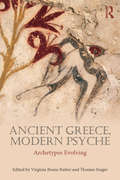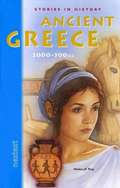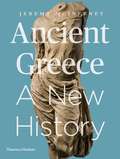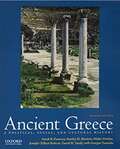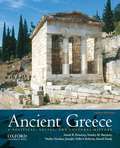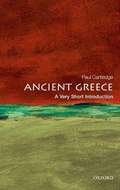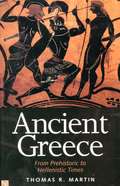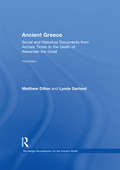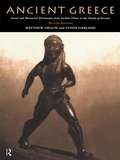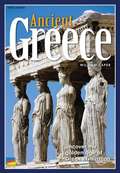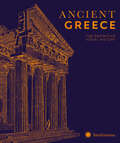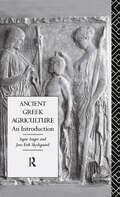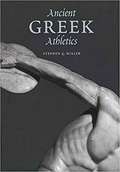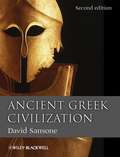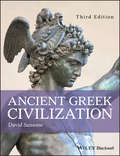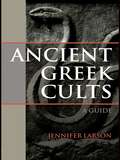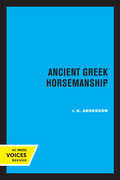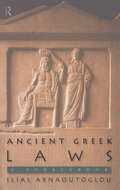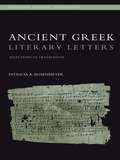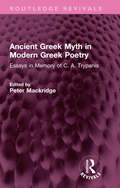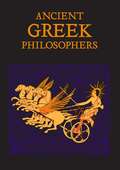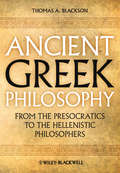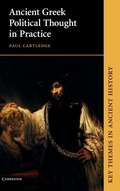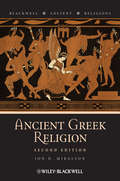- Table View
- List View
Ancient Greece, Modern Psyche: Archetypes Evolving
by Virginia Beane Rutter Thomas SingerBetween ancient Greece and modern psyche lies a divide of not only three thousand years, but two cultures that are worlds apart in art, technology, economics and the accelerating flood of historical events. This unique collection of essays from an international selection of contributors offers compelling evidence for the natural connection and relevance of ancient myth to contemporary psyche, and emerges from the second 'Ancient Greece, Modern Psyche' conference held in Santorini, Greece, in 2012.This volume is a powerful homecoming for those seeking a living connection between the psyche of the ancients and our modern psyche. This book looks at eternal themes such as love, beauty, death, suicide, dreams, ancient Greek myths, the Homeric heroes and the stories of Demeter, Persephone, Apollo and Hermes as they connect with themes of the modern psyche. The contributors propose that that the link between them lies in the underlying archetypal patterns of human behaviour, emotion, image, thought, and memory.Ancient Greece, Modern Psyche: Archetypes Evolving makes clear that an essential part of deciphering our dilemmas resides in a familiarity with Western civilization's oldest stories about our origins, our suffering, and the meaning or meaninglessness in life. It will be of great interest to Jungian psychotherapists, academics and students as well as scholars of classics and mythology.
Ancient Greece: A New History
by Jeremy McInerneyAncient Greece: A New History is a new, single-authored survey of the ancient Greek world that brings the past to life with a fresh narrative and vivid images. Drawing on the latest archaeological research and textual evidence, award-winning teacher and scholar Jeremy McInerney shows that many of the issues that concerned the ancient Greeks--justice and inequality, nationalism and xenophobia, medicine and science--are relevant today. <P><P> Key features include more than 200 color images; chapter-opening timelines, detailed maps and plans; chapter-ending illustrated "Spotlight" features; and instructor and student resources.
Ancient Greece: A Political, Social, And Cultural History
by Sarah B. Pomeroy Stanley M. Burstein Jennifer Tolbert Roberts Walter Donlan David Tandy Georgia TsouvalaWritten by four leading authorities on the classical world, here is a new history of ancient Greece that dynamically presents a generation of new scholarship on the birthplace of Western civilization. Ranging from Greece's first beginnings in the Bronze Age through the tumultuous Hellenistic era dominated by Alexander the Great, this volume offers a truly wide-ranging portrait, blending the traditional political and military approach with a more modern accent on social and cultural history. Everything is included here--the sweeping philosophical systems of Plato and Aristotle, the daily lives of women in Athens, dramatic sea battles in the Aegean, the epic poetry of Homer, the rise of the city-state. The book offers illuminating descriptions of Sparta and Athens, recounts the Persian and Peloponnesian wars, evaluates the contributions of notable figures such as Solon, Cleisthenes, Pericles, and Philip II of Macedon, and discusses the remarkable rise of Alexander the Great. Throughout the book, the editors trace the slow evolution of Greek culture, revealing how the early Greeks borrowed from their neighbors, but eventually developed a distinctive culture of their own, marked by astonishing creativity, versatility, and resilience. Featuring 17 original maps, over 80 photographs, and numerous "document boxes" which highlight a variety of primary source material, this book provides an account of the Greek world that is thoughtful and sophisticated while remaining accessible to the nonscholar. A dynamic collaboration between four renowned scholars Sarah Pomeroy, Stanley M. Burstein, Walter Donlan, and Jennifer Tolbert Roberts it is the definitive portrait of the fountainhead of Western philosophy, literature, science, and art.
Ancient Greece: A Political, Social, And Cultural History
by Sarah B. Pomeroy Stanley M. Burstein Jennifer Tolbert Roberts Walter Donlan David W. TandyRevised and updated throughout, the third edition of Ancient Greece presents the political, social, cultural, and economic history and civilization of ancient Greece in all its complexity and variety. Written by five leading authorities on the classical world, this captivating study covers theentire period from the Bronze Age through the Hellenistic Era.
Ancient Greece: A Very Short Introduction
by Paul CartledgeThe contribution of the Ancient Greeks to modern western culture is incalculable. In the worlds of art, architecture, myth, literature, and philosophy, the world we live in would be unrecognizably different without the formative influence of Ancient Greek models. Ancient Greek civilization was defined by the city - in Greek, the polis, from which we derive "politics". It is above all this feature of Greek civilization that has formed its most enduring legacy, spawning such key terms as aristocracy, oligarchy, tyranny and - last but by no means least -democracy. This stimulating Very Short Introduction to Ancient Greece takes the polis as its starting point. Paul Cartledge uses the history of eleven major Greek cities to illuminate the most important and informative themes in Ancient Greek history, from the first documented use of the Greek language around1400 BCE, through the glories of the Classical and Hellenistic periods, to the foundation of the Byzantine empire in around CE 330. Covering everything from politics, trade, and travel to slavery, gender, religion, and philosophy, it provides the ideal concise introduction to the history and culture of this remarkable civilization that helped give birth to the world as we know it.
Ancient Greece: From Prehistoric to Hellenistic Times
by Thomas R. MartinThis compact, comprehensive, and generously illustrated history of ancient Greece takes us from the Stone Age roots of Greek civilization to the early Hellenistic period following the death of Alexander the Great. Designed for nonspecialist readers, it will be a welcome and needed resource for all who wish to learn about this important subject. Thomas Martin begins with a prehistory of late Stone Age activity that provides background for the conditions of later Greek life. He then describes the civilizations of the Minoans on the island of Crete and of their successors, the Mycenaeans, on the mainland; the Greek Dark Age and the Archaic Age; the Classical Age of Greece in the fifth and fourth centuries B. C. ; the transformation of the kingdom of Macedonia into the greatest power in the Greek world; and the period after the death of Alexander the Great in 323 B. C. , when monarchies emerging from Alexander's fragmented empire once again came to dominate Greek history. The narrative integrates political, military, social, and cultural history, with a focus on the development of the Greek city-state in the eighth to fourth centuries B. C. and on the society, literature, and architecture of Athens in its Golden Age. The book, which includes useful timelines, maps, plans, and photographs, was adapted from and may be cross-referenced with the historical overview of Greece that is part of the multimedia interactive database Perseus: Interactive Sources and Studies on Ancient Greece, versions 1. 0 and 2. 0. The book extends the coverage of the Perseus overview, with its new sections on Greek prehistory, the Bronze and Dark Ages, and the Hellenistic period.
Ancient Greece: Social and Historical Documents from Archaic Times to the Death of Alexander the Great (Routledge Sourcebooks for the Ancient World)
by Matthew Dillon Lynda GarlandIn this revised edition, Matthew Dillon and Lynda Garland have expanded the chronological range of Ancient Greece to include the Greek world of the fourth century. The sourcebook now ranges from the first lines of Greek literature to the death of Alexander the Great, covering all of the main historical periods and social phenomena of ancient Greece. The material is taken from a variety of sources: historians, inscriptions, graffiti, law codes, epitaphs, decrees, drama and poetry. It includes the major literary authors, but also covers a wide selection of writers, including many non-Athenian authors. Whilst focusing on the main cities of ancient Greece - Athens and Sparta- the sourcebook also draws on a wide range of material concerning the Greeks in Egypt, Italy, Sicily, Asia Minor and the Black Sea. Ancient Greece covers not only the chronological, political history of ancient Greece, but also explores the full spectrum of Greek life through topics such as gender, social class, race and labour. This revised edition includes: Two completely new chapters - "The Rise of Macedon" and "Alexander ′the Great′, 336-323" BC New material in the chapters on The City-State, Religion in the Greek World, Tyrants and Tyranny, The Peloponnesian War and its Aftermath, Labour: Slaves, Serfs and Citizens, and Women, Sexuality and the Family It is structured so that: Thematically arranged chapters arranged allow students to build up gradually knowledge of the ancient Greek world Introductory essays to each chapter give necessary background to understand topic areas Linking commentaries help students understand the source extracts and what they reveal about the ancient Greeks Ancient Greece: Social and Historical Documents from Archaic Times to the Death of Alexander the Great. Third Edition, will continue to be a definitive collection of source material on the society and culture of the Greeks.
Ancient Greece: Social and Historical Documents from Archaic Times to the Death of Socrates
by Matthew Dillon Lynda GarlandCollection of historical Greek documents
Ancient Greece: The Definitive Visual History (DK Classic History)
by DKEmbark upon a lavish visual journey through ancient Greece—its origins, its rise and fall, and its legacy that still permeates the Western world today.Spanning more than 3,000 years, Ancient Greece explores the tumultuous history of this glorious empire in vivid detail—from its Minoan and Mycenaean origins to the apogee of the warring city-states of Athens and Sparta, and from the death of its most charismatic leader, Alexander the Great, to its ultimate defeat by Rome.Sumptuous photography and authoritative, engaging text cover every facet of life in ancient Greece, from art, entertainment, and schools of thought to politics, medicine, and war, while myths and religious beliefs are explored and explained in visual context.Greece’s military and political power shines through attractive and detailed maps of its legendary battles. The buried palaces and Athenian agoras where Plato and Socrates discussed philosophy are brought back to life with specially commissioned CGI recreations, while the stories of ordinary citizens, policymakers, and the first Olympic athletes are told with the help of illustrations, artifacts, and eyewitness accounts.
Ancient Greek Agriculture: An Introduction
by Signe Isager Jens Erik SkydsgaardThe initial focus of Ancient Greek Agriculture is firmly on the art of agriculture proper, the tools and the technique, the plants cultivated and the animals reared. Thereafter, Isager and Skydsgaard focus on the position of agriculture in the society of gods and men in the Greek city-states . The arguments of Ancient Greek Agriculture are strengthened by the book's close adherence to contemporary Greek sources, literary as well as archaeological, avoiding the use of later as well as Roman material.
Ancient Greek Athletics
by Stephen G. MillerThe earliest Olympic games began more than twenty-five-hundred years ago. What were they like, how were they organised, who participated? Were ancient sports a means of preparing youth for warfare? In this lavishly illustrated book, a world expert on ancient Greek athletics provides the first comprehensive introduction to the subject, vividly describing ancient sporting events and games and exploring their impact on art, literature, and politics. Using a wide array of ancient sources, written and visual, and including recent archaeological discoveries, Stephen Miller reconstructs ancient Greek athletic festivals and the details of specific athletic events. He also explores broader themes, including the role of women in ancient athletics, the place of amateurism, and the relationship between athletic events and social and political life. Published in the year the modern Olympic Games return to Athens, this book will be a source of information and enjoyment for anyone interested in the history of athletics and the origins of the world's most famous sporting event.
Ancient Greek Civilization
by David SansoneA concise narrative of Greek history and an analysis of the literature, art, and thought of the ancient Greeks. Tells the story of Greek civilization from the from the Minoan Period to the time of the Byzantine Empire Surveys the remarkable culture and history the ancient Greeks Explores the ways in which Greek civilization has been continually reinvented from antiquity to the present day Updated edition includes additional illustrations, maps, and timelines, a glossary, and an annotated bibliography
Ancient Greek Civilization
by David SansoneThe third edition of Ancient Greek Civilization is a concise, engaging introduction to the history and culture of ancient Greece from the Minoan civilization to the age of the Roman Empire. Explores the evolution and development of Greek art, literature, politics, and thought across history, as well as the ways in which these were affected by Greek interaction with other cultures Now includes additional illustrations and maps, updated notes and references throughout, and an expanded discussion of the Hellenistic period Weaves the latest scholarship and archeological excavations into the narrative at an appropriate level for undergraduates
Ancient Greek Cults: A Guide
by Jennifer LarsonUsing archaeological, epigraphic, and literary sources; and incorporating current scholarly theories, this volume will serve as an excellent companion to any introduction to Greek mythology, showing a side of the Greek gods to which most students are rarely exposed. Detailed enough to be used as a quick reference tool or text, and providing a readable account focusing on the oldest, most widespread, and most interesting religious practices of the ancient Greek world in the Archaic and Classical periods, Ancient Greek Cults surveys ancient Greek religion through the cults of its gods and goddesses, heroes and heroines. Jennifer Larson conveniently summarizes a vast amount of material in many languages, normally inaccessible to undergrad students, and explores, in detail, the variety of cults celebrated by the Greeks, how these cults differed geographically, and how each deity was conceptualized in local cult titles and rituals. Including an introductory chapter on sources and methods, and suggestions for further reading this book will allow readers to gain a fresh perspective on Greek religion.
Ancient Greek Horsemanship
by J. K. AndersonThis title is part of UC Press's Voices Revived program, which commemorates University of California Press’s mission to seek out and cultivate the brightest minds and give them voice, reach, and impact. Drawing on a backlist dating to 1893, Voices Revived makes high-quality, peer-reviewed scholarship accessible once again using print-on-demand technology. This title was originally published in 1961.
Ancient Greek Laws: A Sourcebook (Routledge Sourcebooks for the Ancient World)
by Ilias ArnaoutoglouIn this comprehensive and accessible sourcebook, Ilias Arnaoutoglou presents a collection of ancient Greek laws, which are situated in their legal and historical contexts and are elucidated with relevant selections from Greek literature and epigraphical testimonies. A wide area of legislative activity in major and minor Greek city-states, ranging from Delphoi and Athens in mainland Greece, to Gortyn in Crete, Olbia in South Russia and Aegean cities including Ephesos, Samos and Thasos, is covered. Ilias Arnaoutoglou divides legislation into three main areas:* the household - marriage, divorce, inheritance, adoption, sexual offences and personal status* the market-place - trade, finance, sale, coinage and leases* the state - constitution, legislative process, public duties, colonies, building activities, naval forces, penal regulations, religion, politics and inter-state affairs.Dr Arnaoutoglou explores the significance of legislation in ancient Greece, the differences and similarities between ancient Greek legislation and legislators and their modern counterparts and also provides fresh translations of the legal documents themselves.
Ancient Greek Literary Letters: Selections in Translation
by Patricia A. RosenmeyerThe first referenece to letter writing occurs in the first text of western literature, Homer's Iliad. From the very beginning, Greeks were enthusiastic letter writers, and letter writing became a distinct literary genre. Letters were included in the works of historians but they also formed the basis of works of fiction, and the formal substructure for many kinds of poem. Patricia Rosenmeyer, an authority on the history of the Greek letter, assembles in this book a representative selection of such 'literary letters', from Aelian and Alciphron to Philostrartus and the supposed letters of Themistocles. The book will be valuable for all students of Greek literature especially those studying Greek (and Latin) letter.
Ancient Greek Music
by Stefan HagelThis 2009 book endeavours to pinpoint the relations between musical, and especially instrumental, practice and the evolving conceptions of pitch systems. It traces the development of ancient melodic notation from reconstructed origins, through various adaptations necessitated by changing musical styles and newly invented instruments, to its final canonical form. It thus emerges how closely ancient harmonic theory depended on the culturally dominant instruments, the lyre and the aulos. These threads are followed down to late antiquity, when details recorded by Ptolemy permit an exceptionally clear view. Dr Hagel discusses the textual and pictorial evidence, introducing mathematical approaches wherever feasible, but also contributes to the interpretation of instruments in the archaeological record and occasionally is able to outline the general features of instruments not directly attested. The book will be indispensable to all those interested in Greek music, technology and performance culture and the general history of musicology.
Ancient Greek Myth in Modern Greek Poetry: Essays in Memory of C. A. Trypanis (Routledge Revivals)
by Peter MackridgeOriginally published in 1996, this volume contains essays by scholars, critics and translators and includes themes such as the myth in the Cretan Renaissance and the use of ancient myth by 19th and 20th Century poets. Some essays deal with individual mythical figures such as Odysseus, Orpheus, Prometheus and Aphrodite, while others deal with the problematic issue of the use of myth by Greek women poets. The discussion is completed by comparing attitudes to the ancient Greeks as embodied in English and modern Greek poetry.
Ancient Greek Philosophers (Leather-bound Classics)
by Kenneth C. Mondschein Editors of Canterbury Classics"Philosophy begins in wonder." --PlatoHave you ever wondered about the development of civilization? What topics were discussed in the days of Ancient Greece? This collection of thoughts from Plato, Aristotle, and other masters of philosophy will lead your mind on a journey of enlightened exploration into ethics, morality, law, medicine, and more. With an introduction by a distinguished scholar of classic literature, this Canterbury Classics volume is sure to be a favorite keepsake edition.
Ancient Greek Philosophy: From the Presocratics to the Hellenistic Philosophers
by Thomas A. BlacksonAncient Greek Philosophy: From the Presocratics to the Hellenistic Philosophers presents a comprehensive introduction to the philosophers and philosophical traditions that developed in ancient Greece from 585 BC to 529 AD. Provides coverage of the Presocratics through the Hellenistic philosophers Moves beyond traditional textbooks that conclude with Aristotle A uniquely balanced organization of exposition, choice excerpts and commentary, informed by classroom feedback Contextual commentary traces the development of lines of thought through the period, ideal for students new to the discipline Can be used in conjunction with the online resources found at http://tomblackson.com/Ancient/toc.html
Ancient Greek Political Thought in Practice
by Paul CartledgeAncient Greece was a place of tremendous political experiment and innovation, and it was here too that the first serious political thinkers emerged. Using carefully selected case-studies, Professor Cartledge investigates the dynamic interaction between ancient Greek political thought and practice from early historic times to the early Roman Empire. Of concern throughout are three major issues: first, the relationship of political thought and practice; second, the relevance of class and status to explaining political behaviour and thinking; third, democracy - its invention, development and expansion, and extinction, prior to its recent resuscitation and even apotheosis. In addition, monarchy in various forms and at different periods and the peculiar political structures of Sparta are treated in detail over a chronological range extending from Homer to Plutarch. The book provides an introduction to the topic for all students and non-specialists who appreciate the continued relevance of ancient Greece to political theory and practice today.
Ancient Greek Religion (Blackwell Ancient Religions #15)
by Jon D. MikalsonAncient Greek Religion provides an introduction to the fundamental beliefs, practices, and major deities of Greek religion. Focuses on Athens in the classical period Includes detailed discussion of Greek gods and heroes, myth and cult, and vivid descriptions of Greek religion as it was practiced Ancient texts are presented in boxes to promote thought and discussion, and abundant illustrations help readers visualize the rich and varied religious life of ancient Greece Revised edition includes additional boxed texts and bibliography, an 8-page color plate section, a new discussion of the nature of Greek “piety,” and a new chapter on Greek Religion and Greek Culture
